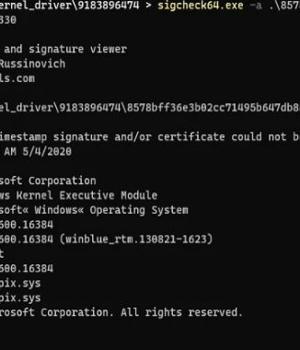Security News > 2023 > May > New WinTapix.sys Malware Engages in Multi-Stage Attack Across Middle East

An unknown threat actor has been observed leveraging a malicious Windows kernel driver in attacks likely targeting the Middle East since at least May 2020.
A key security measure to mitigate against malicious drivers is Driver Signature Enforcement, which ensures that only drivers signed by Microsoft can be loaded on the system.
The tech giant also maintains driver block rules to protect against known vulnerable drivers.
Sys, on the other hand, comes with an invalid signature, indicating that the threat actor will have to first load a legitimate but vulnerable driver in order to launch WINTAPIX. UPCOMING WEBINAR. Zero Trust + Deception: Learn How to Outsmart Attackers!
The development comes as the ALPHV ransomware group has been observed taking advantage of a malicious signed driver to impair security defenses and escape detection for extended periods of time.
POORTRY is the name assigned to a Windows kernel driver that comes with capabilities to terminate security software.
News URL
https://thehackernews.com/2023/05/new-wintapixsys-malware-engages-in.html
Related news
- Multi-Stage Malware Attack Uses .JSE and PowerShell to Deploy Agent Tesla and XLoader (source)
- Nebulous Mantis Targets NATO-Linked Entities with Multi-Stage Malware Attacks (source)
- New TCESB Malware Found in Active Attacks Exploiting ESET Security Scanner (source)
- New Android malware steals your credit cards for NFC relay attacks (source)
- Hackers Abuse Russian Bulletproof Host Proton66 for Global Attacks and Malware Delivery (source)
- SuperCard X Android Malware Enables Contactless ATM and PoS Fraud via NFC Relay Attacks (source)
- SK Telecom warns customer USIM data exposed in malware attack (source)
- DslogdRAT Malware Deployed via Ivanti ICS Zero-Day CVE-2025-0282 in Japan Attacks (source)
- Malware Attack Targets World Uyghur Congress Leaders via Trojanized UyghurEdit++ Tool (source)
- Disney Slack attack wasn't Russian protesters, just a Cali dude with malware (source)